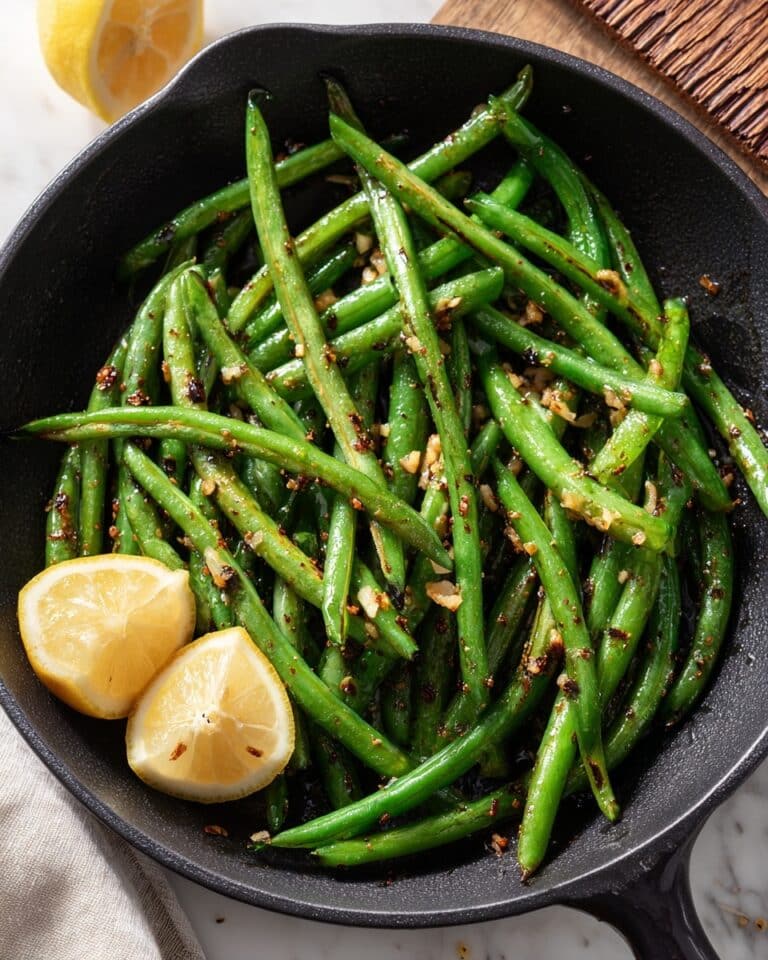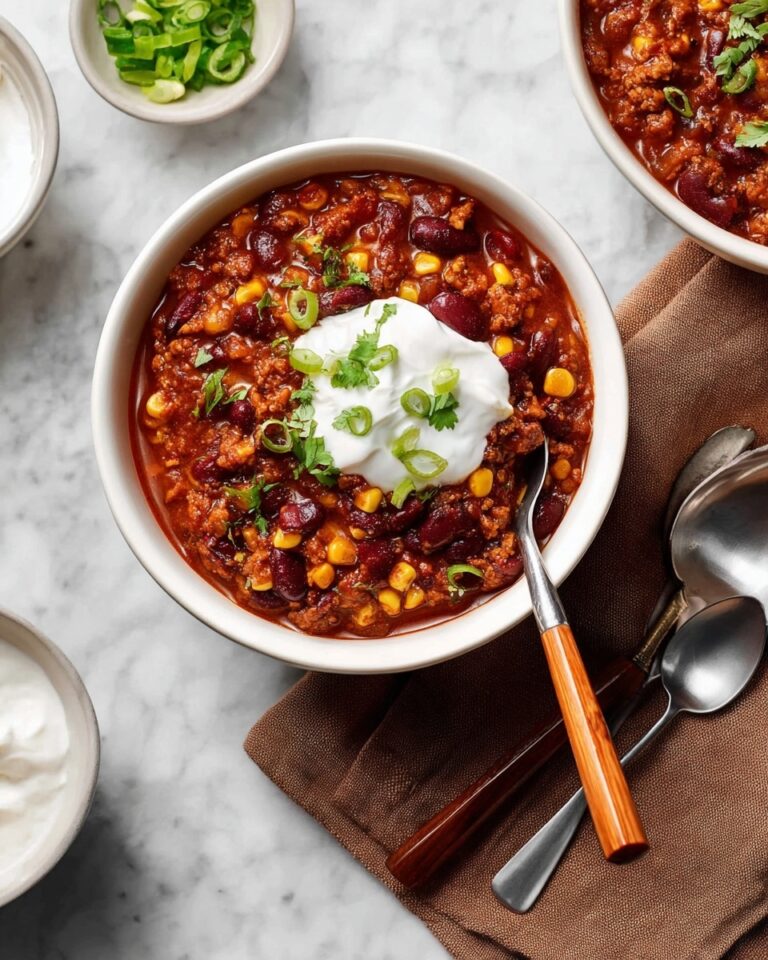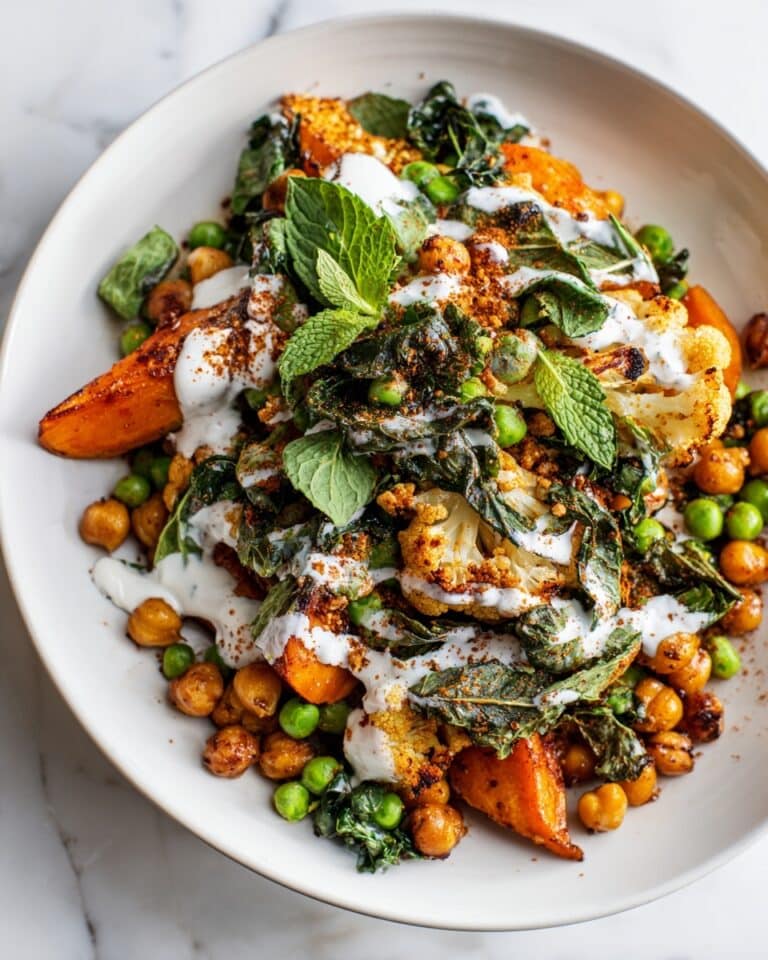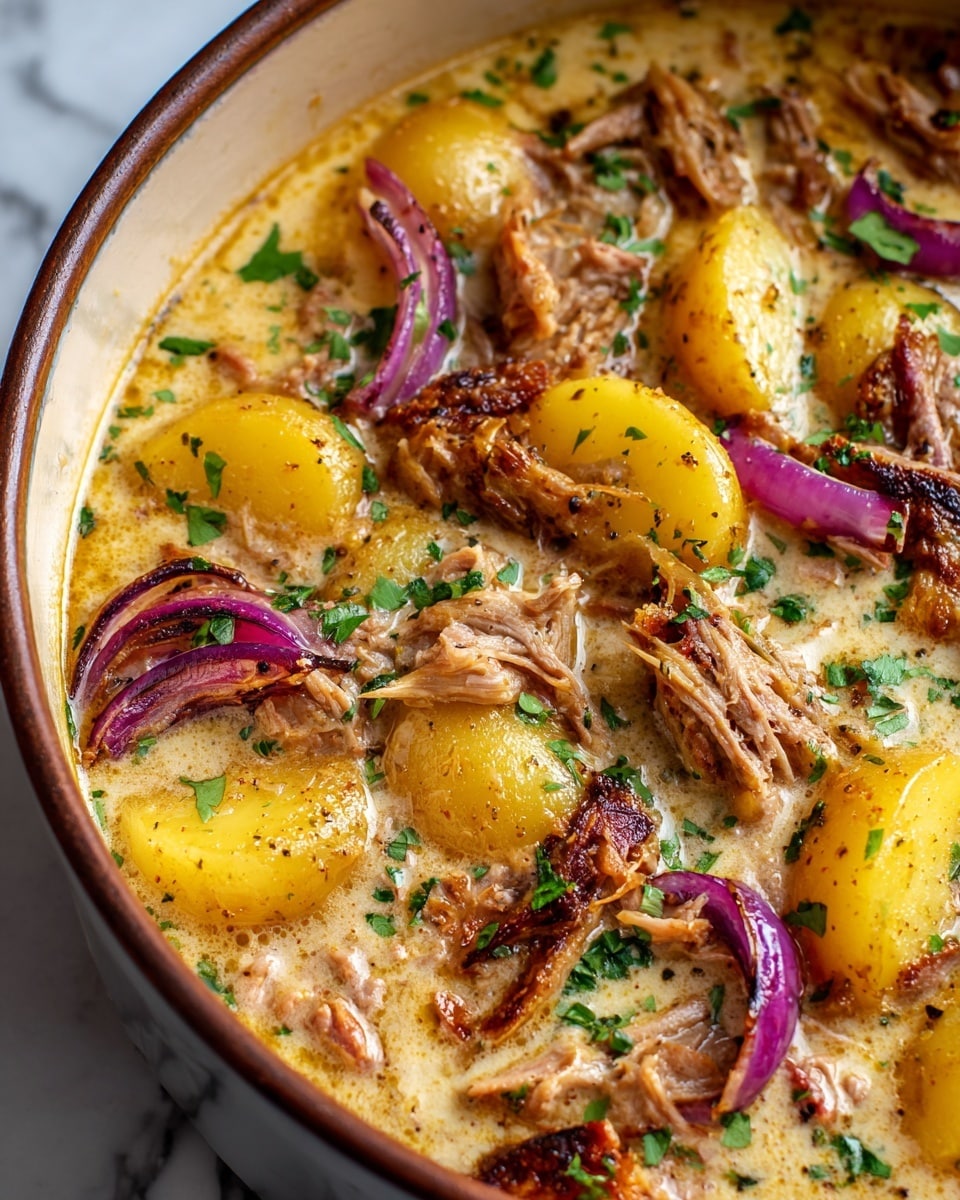
This recipe stands out because it’s a beautiful balance of flavors and textures. The pork comes out fork-tender, infused with a subtle sweetness from the apple cider, undercut by the savory punch of herbs like thyme and rosemary. The tender onion and apple wedges soak up the braising liquid, adding fresh layers of flavor and a lovely contrast to the meaty richness. The color of the golden-braised pork paired with the rosy apples is just as comforting as the warm aroma inviting everyone to the table.
And don’t worry if you haven’t done a braise before—I promise you this Apple Cider Braised Pork Shoulder Recipe is totally approachable. I’ll walk you through every step so you’re never lost, and share tips to get it right the first time. Trust me, you’ll love how effortless it is to make a restaurant-worthy dish at home with minimal hands-on time. Ready to make this magic happen together?
What Makes This Recipe Special
- Flavor Harmony: The combination of apple cider’s sweetness and fresh herbs creates a perfectly balanced savory-sweet profile.
- Easy Assembly: Minimal prep and one-pot braising make it hands-off while delivering complex flavors.
- Texture Play: Tender pork contrasts with softened apple and onion wedges that soak up all those delicious juices.
- Showstopper Finish: Resting and spooning garlic-enriched braising liquid over the pork delivers layers of lusciousness in every bite.
Gather Your Ingredients
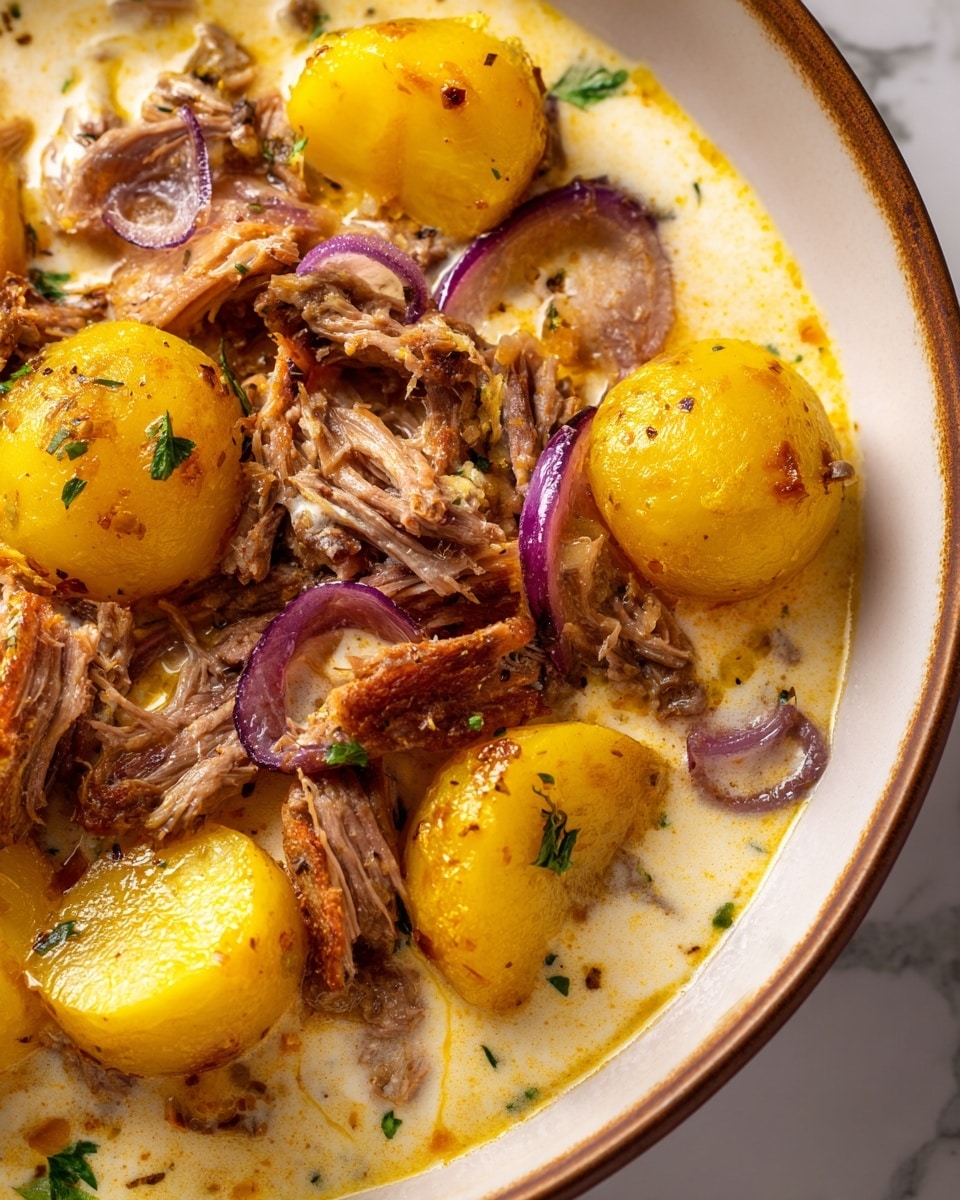
Ingredients You’ll Need
Before you start cooking, it’s helpful to get all your ingredients measured and ready. Exact amounts you need for this Apple Cider Braised Pork Shoulder Recipe are detailed in the printable recipe card at the bottom. Here’s a quick overview of what you’ll want to have on hand:
- Pork shoulder roast: Also called Boston butt; a well-marbled cut that braises beautifully and stays juicy.
- Neutral oil: Like canola or vegetable oil for searing without overpowering flavors.
- Fresh apple cider: Use fresh cider (not vinegar) for natural sweetness and depth.
- Chicken stock or broth: Adds savory richness to the braising liquid.
- Dijon mustard: Lends subtle tang and helps emulsify the braising liquid.
- Dehydrated minced onion: Convenient and concentrates onion flavor without chopping.
- Garlic head: Roasted whole during braising, it turns sweet and spreadable.
- Fresh rosemary and thyme: Aromatic herbs that infuse the pork with earthy notes.
- Red onion: Thick slices add sweetness and texture in the final stages.
- Firm tart apples: Such as Granny Smith, peeled and wedged to hold shape and add bright contrast.
- Kosher salt & freshly cracked black pepper: Essential to season and enhance all ingredients.
If you can’t find fresh apple cider, a mix of unsweetened apple juice and a pinch of cider vinegar can work in a pinch. Feel free to swap chicken stock with vegetable broth for a lighter twist.
Chef’s Note
You’ll find the complete list of ingredients with exact measurements in the printable recipe card at the bottom of this post.
Kitchen Tools Required
- Large Dutch oven or heavy ovenproof pot: Provides even heat for searing and braising in one vessel.
- Paper towels: For drying pork—key to getting a good sear.
- Whisk: To blend the braising liquid smoothly.
- Kitchen twine: Ties herbs into a bundle, making removal easy.
- Meat thermometer: Helps you check doneness without cutting into the pork.
- Oven mitts and sturdy tongs: For safe handling while searing and braising.
How to Make Apple Cider Braised Pork Shoulder Recipe
Ready to dive in? This Apple Cider Braised Pork Shoulder Recipe comes together in stages starting with searing, then slow braising in flavorful liquid, followed by a final bake with apples and onions to add sweetness and texture. Let’s get that oven heated and your Dutch oven out.
- Preheat and prep: Set your oven to 325°F. Trim excess fat from the pork shoulder and either cut it into four large pieces or leave whole if bone-in. Pat dry with paper towels and season generously with kosher salt and cracked pepper all over.
- Sear the pork: Heat neutral oil over medium-high in your Dutch oven. Add pork in a single layer, and sear for 4-5 minutes per side until deeply browned. Browning in batches is fine to avoid overcrowding the pan—this caramelization builds flavor.
- Mix braising liquid: While searing, whisk together 2 cups fresh apple cider, 2 cups chicken stock, 2 tbsp Dijon mustard, and 1 tbsp dehydrated minced onion. Set aside.
- Bundle herbs: Tie together fresh rosemary and thyme sprigs with kitchen twine for easy removal later.
- Combine and braise: Nestle browned pork into the pot and pour over the braising liquid. Add the herb bundle and the garlic head, sliced on top (not chopped). Cover with lid and transfer to the oven.
- Slow-cook: Braise for about 3 hours, flipping the pork halfway through. If pork is boneless, start checking tenderness at 2.5 hours—the meat should be just shy of fork tender before next step.
- Add apples & onions: Arrange thick red onion slices and peeled apple wedges around the pork in the pot. Cover and return to the oven for another 30-45 minutes, until pork is very tender and aromatics soften.
- Rest & serve: Remove from oven and let pork rest in the braising liquid for 30 minutes. Squeeze sweet roasted garlic cloves from the husk onto the pork or into the juices. Season liquid with salt and pepper to taste. Spoon the braising juices generously over everything when plating.
Cooking Secrets
- Tip 1: Pat your pork very dry before searing to get a rich crust that seals in juices.
- Tip 2: Don’t rush the browning step—it adds layers of flavor that braising alone can’t provide.
- Tip 3: Use a meat thermometer to check when the pork reaches about 190°F internal for tender fall-apart texture.
- Tip 4: Resting the pork in its braising liquid lets the flavors deepen and meat stay succulent before serving.
How to Serve
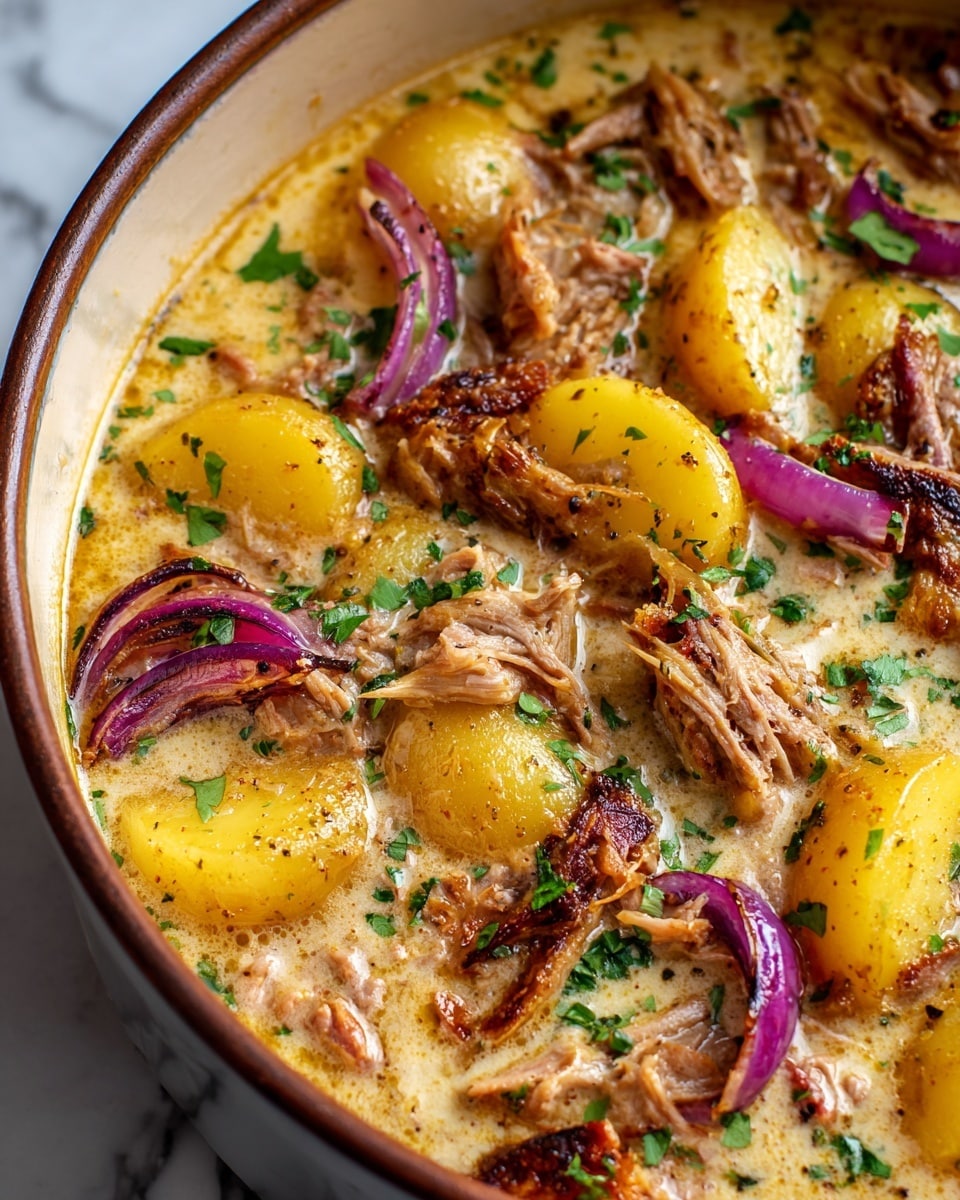
Taste Enhancers
Spoon some of the braising liquid and roasted garlic over the pork right before serving for a silky, savory finish. A drizzle of a mustard sauce or a splash of apple cider vinegar can brighten the richness. If you like a touch of heat, a sprinkle of chili flakes or a smear of hot mustard works beautifully.
Tasty Combos
This pork shines served alongside creamy mashed potatoes, buttered egg noodles, or rustic roasted root vegetables. To drink, try a crisp hard apple cider or a lightly chilled Riesling—their acidity cuts through the richness perfectly. A simple green salad with vinaigrette can also add fresh balance.
Serving Tips
For gatherings, serve the pork shoulder shredded or sliced thickly, with bowls of apples and onions on the side. It also makes a fantastic sandwich filling the next day. When plating for special occasions, arrange apples and onions around the meat, drizzle with juices, and garnish with fresh herbs to impress your guests visually and in flavor.
Easy Variations
- Swap fresh apple cider for pear cider for a subtle twist on sweetness.
- Add a splash of dry white wine to the braising liquid for added acidity and aroma.
- Use bone-in pork shoulder for extra richness and flavor.
- Include a few cinnamon sticks or star anise in the braising liquid for warm spice notes.
- Make it dairy-free simply by choosing vegetable broth instead of chicken stock.
- For a tangy contrast, serve with a side of tangy apple slaw or pickled red onions.
Storing and Reheating Tips
- Store leftover pork shoulder in an airtight container with the braising liquid for up to 4 days in the refrigerator.
- Freeze leftovers for up to 3 months; defrost overnight in the refrigerator before reheating.
- Reheat gently on the stovetop over low heat in the braising liquid to keep pork moist.
- If microwaving, add a splash of braising liquid and cover loosely to retain moisture.
Common Questions
- Can I use apple cider vinegar instead of fresh apple cider? It’s best to use fresh apple cider for sweetness; vinegar will make it too tart and change the flavor balance.
- What if I don’t have a Dutch oven? Use any heavy, oven-safe pot with a tight-fitting lid, or braise in a roasting pan covered tightly with foil.
- Is pork shoulder the best cut for this recipe? Yes, because of its marbling and connective tissue, which breaks down into tender, flavorful meat during braising.
- How do I know when the pork is done? It should be tender enough to easily shred with a fork; an internal temperature around 190°F is ideal for pull-apart texture.
- Can I prepare this recipe ahead of time? Absolutely! It often tastes even better the next day after flavors meld. Just reheat gently.
Apple Cider Braised Pork Shoulder Recipe
This Apple Cider Braised Pork Shoulder is a comforting and flavorful dish featuring tender pork slowly cooked in a savory apple cider and chicken broth mixture. Aromatic herbs, garlic, onions, and tart apples enhance the dish, making it perfect for a hearty dinner.
- Prep Time: 20 minutes
- Cook Time: 3 hours 45 minutes
- Total Time: 4 hours 5 minutes
- Yield: 6 servings
- Category: Main Course
- Method: Baking
- Cuisine: American
Ingredients
Pork and Seasoning
- 4-5 lb pork shoulder roast or Boston butt roast
- 2 tablespoons neutral oil
- Kosher salt to taste
- Freshly cracked black pepper to taste
Braising Liquid
- 2 cups fresh apple cider
- 2 cups chicken stock or broth
- 2 tablespoons Dijon mustard
- 1 tablespoon dehydrated minced onion
Aromatics and Vegetables
- 1 head of garlic, top sliced off opposite of the root end
- 3 rosemary sprigs
- 4 thyme sprigs
- 1 red onion, cut into thick slices
- 2 firm and slightly tart apples, peeled and cut into wedges
Instructions
- Preheat oven. Preheat your oven to 325 degrees Fahrenheit to prepare for the braising process.
- Prepare the pork. Trim excess fat from the pork shoulder if necessary. Cut into 4 large pieces or leave whole if bone-in. Pat dry and season generously with kosher salt and freshly cracked black pepper on all sides.
- Sear the pork. Heat neutral oil in a large Dutch oven over medium-high heat. Once hot, sear the pork pieces in a single layer, browning each side for 4-5 minutes until deeply browned. Work in batches if needed to avoid overcrowding.
- Prepare braising liquid. While searing, whisk together fresh apple cider, chicken stock or broth, Dijon mustard, and dehydrated minced onion in a bowl. Tie rosemary and thyme together with kitchen twine.
- Begin braising. Pour the braising liquid into the Dutch oven over the browned pork. Arrange the herb bundle and garlic head in the pot. Cover the pot and place it in the preheated oven.
- Braise the pork. Cook for 3 hours total, flipping the pork halfway through the cooking time. Start checking for tenderness at 2 and a half hours if the pork is boneless. The pork should be just shy of fork tender when done.
- Add apples and onions. Remove the pot briefly from the oven. Arrange the red onion slices and apple wedges around the pork. Cover and return to the oven for an additional 30-45 minutes until the pork is very tender.
- Rest and serve. Remove pork from the oven and let it rest in the braising liquid for 30 minutes to absorb flavors. Squeeze roasted garlic cloves out of their husk into the broth or directly onto the pork. Season the braising liquid with salt and pepper to taste. Serve spooning the flavorful juices over the pork, apples, and onions.
Notes
- Use fresh apple cider, not apple cider vinegar, for the best flavor balance in the braising liquid.
- Searing the pork well develops deeper flavors and texture.
- Adjust seasoning at the end as braising liquids reduce and intensify.
- Boneless pork shoulder will tenderize slightly faster than bone-in; begin tenderness checks at 2 hours 30 minutes.
- Roasted garlic can be mashed and spread on the pork for extra flavor.
- If a Dutch oven is unavailable, use a deep oven-safe pot with a tight-fitting lid.




